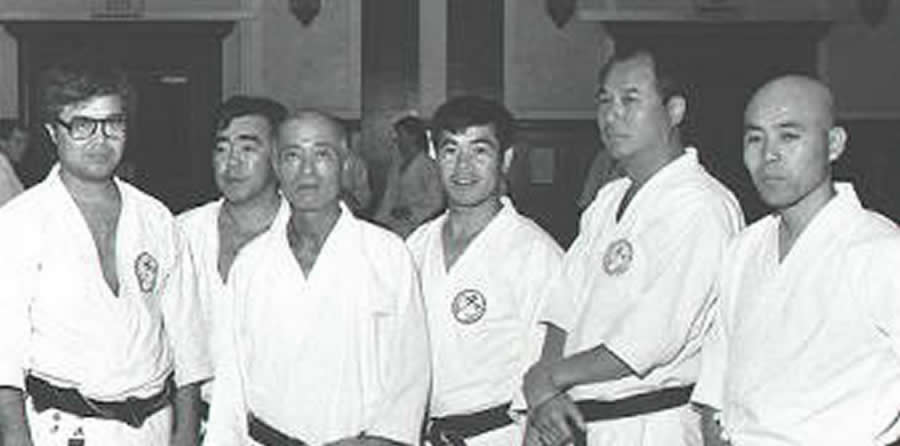The History of Wado Karate – cont.
page 5

In the early postwar years, wado-kai got its first permanent home, a hombu dojo (Sanko Dojo) in front of the Tsukiji Police Station in downtown Tokyo. It had a wooden floor large enough for 24 mats. After three years, however, Otsuka shifted his dojo headquarters to the gymnasium of the Nakano Primary School in north Tokyo where it is still situated. Later around 1949, Otsuka’s son Jiro began to study Wado, as well as Iaido, Kendo, and Judo; and would begin the training that would one day carry on the tradition of his father.
During the 50s and 60s, Wado continued to grow in Japan becoming one of the 4 largest styles of karate. In 1951, the ban on the practice of Martial Arts was lifted, and Wado Was ready for its next to take the step from a style previously contained within Japan, to a style that would soon reach around the world.
In 1952, Otsuka instituted “Wado-Ryu Rules” and the Wado-Ryu headquarters was established in the Meiji University karate club and in the Osaki Police Station Budojo.
In 1954 it’s name was changed to Zen Nippon Karate Renmei (All Japan Karate Federation) though it was a Wado Ryu private organization. A demonstration (embu-kai) in commemoration of 20th anniversary of Wado-Ryu and to celebrate the foundation of “Zen Nippon Karatedo Renmei” was held at Hibiya Public Hall. This was the same year that Otsuka awarded Tatsuo Suzuki with the rank of 5th Dan, which was the highest rank given in Wado at that time. Thereafter, Otsuka named Suzuki the head instructor of the Tokai Region in Japan. Suzuki moved to Hamamatsu city and taught in many clubs and universities, throughout the area and was responsible for Wado Ryu becoming the leading style of karate in the Tokai Region; this as a foreshadowing of what was to come later down the road.
In 1955, Otsuka published the book, “Karatejutsu no Kenkyu”, which demonstrated the nine core Wado katas, and was the basis for his 1970 book, “Wado Ryu Karate”.
As the 60s began, Otsuka began to send instructors to Europe and America to begin demonstrating Wado to the West. In 1963, Tatsuo Suzuki, along with Toru Arakawa and Hajimu Takashima were the first to begin this westward movement of Wado, and the impression they left would make Wado soon to be recognized world-wide. In 1964 the name Wadokai was established under Japan Karate Federation (JKF). Thereafter other notable instructors began to move to Europe and teach Wado; familiar names such as: Mochizuki, Kojima, Kono, Toyama, Shiomitsu, Iwasaki ,Takamizawa, Sakagami, Kamigaito, Ohgami, etc; as well as instructors that began to teach Wado in the US like, Ajari, Osaka, Abe, Nishimura, Kurobane, Patterson , etc.
In 1965, Otsuka Sensei along with Yoshiaki Ajari, recorded onto film, which is now still available on two video tapes, much of his legacy of Wado Ryu Karate. The first video, Wado Ryu Karate Volume 1, consists of: Indepth history and recollections, demonstrations of the 8 Kihon No Tsuki body shifts, the first 5 Kihon Gumite, and the katas: Pinans 1-5, Kusanku, Jion, Naihanchi, Seisan. The second video, Wado Ryu Karate Volume 2 consists of: more history, plus the katas Chinto, Niseishi, Rohai, Wanshu, and Jutte, as well as Kohin Gumite 6-10, along with application. These Wado treasures are still available.
In 1967 the Emperor of Japan awarded Master Otsuka the Fifth Order of Merit (the Shiju Hoosho Medal), and the Soko-Kyokujitsu-Sho Medal for his outstanding contributions to karate. He was the first karate master to receive this distinguished award.
In 1968 Otsuka instructed Cecil T. Patterson to establish the U.S. Eastern Wado Karate Federation, to oversee Wado instruction in the Eastern US. Around this same time, Yoshiaki Ajari was instructed to establish the U.S. Wado Kai Karatedo Federation, to oversee Wado instruction in the Western US.